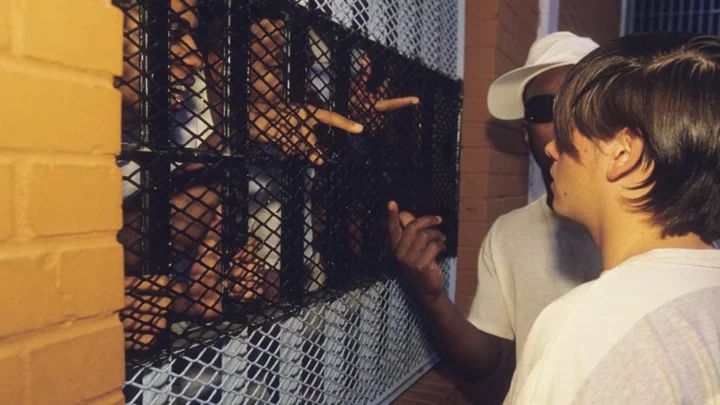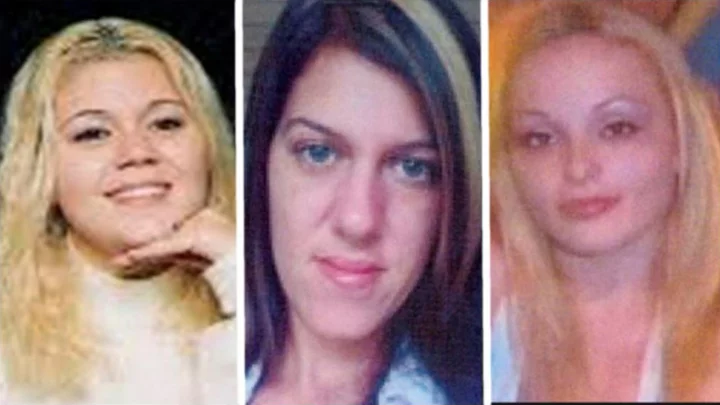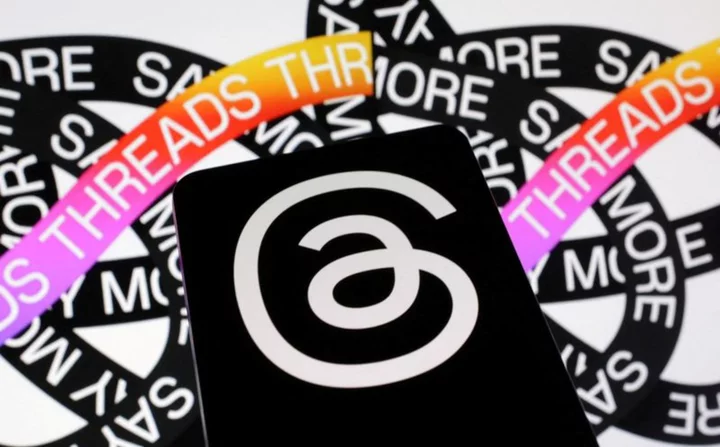“Man, get that f**king camera out of my face! I told you to cut it off!”
Los Angeles viewers tuning into television station KTLA on November 2, 1978, were warned that the program they were about to watch contained explicit language. But few were prepared for the cascade of profanity that accompanied Scared Straight (which was stylized as Scared Straight!). The documentary took a harsh look at life inside a New Jersey state program that ushered in juvenile offenders to be verbally scolded by those incarcerated in a maximum security prison.
No truth was reserved for the teens, who listened as offenders described the life awaiting them if they continued to commit crimes. One by one, they heard stories of murder, beatings, sexual assault, gangs, and more.
While the program initially boasted of success in reducing recidivism, its effectiveness would later be called into question. But in the moment, parents and teens alike were shocked. Scared Straight was an early glimpse of reality television, and the reality wasn’t pretty.
Life Sentence
The Scared Straight concept began in 1976 at Rahway State Prison as the Juvenile Awareness Program, a initiative that was created in the hopes of keeping youth offenders from following a road that was likely to lead to incarceration. Roughly 75 of the prison's population of 1300 participated, meeting with kids twice a day during the week. The idea was to be as blunt about the reality of prison life as possible.
“Many of these kids have nothing to go on except a Hollywood-stereotype image of what convicts are and what prisons are really about,” Frank Bindhammer, one of the program’s founders, said in 1978. “No one comes out and tells them exactly how it is. ... You can’t be a big brother. We want to be the most despicable people in the world to them so they won’t identify with us. We’re not cool; we’re society’s failures.” (Bindhammer was convicted of murder and spent 16 years in prison before getting paroled in 1978.)
KTLA decided to invest $50,000 in a documentary about the program in the hopes of raising awareness and potentially convincing California state prisons to embrace the approach. Arnold Shapiro, a KTLA employee, wrote, produced, and directed it; Peter Falk (Columbo) was the narrator and host.
In total, 17 teenagers were profiled in the film, which follows them into Rahway as they’re introduced to a revolving door of people convicted of a crime and looking to dispel any notion that prison is a badge of honor. After being chastised by the adults, the teens are locked in a room with them and harassed further, sometimes to the point of tears.
“I’ll knock you in the motherf**king mouth with this shoe,” one threatens.
“Grab it, motherf**ker!” another yells at a teen, insisting he grab the incarcerated person’s pocket in an act of submission. “This sh*t is mine now.”
The reaction was immediate: Nearly 1 million people tuned into the broadcast in the Los Angeles area alone. (It eventually aired on stations throughout the country.) KTLA was deluged with viewer mail and phone calls, the vast majority of which praised the program. (Though not universal: One columnist was baffled by how audiences appeared indifferent to the deplorable prison conditions described by those incarcerated, as though that was acceptable.) Bindhammer was even hired by Signal, the parent company of KTLA, to travel with the film and consult with any entity interested in starting a program of their own.
Scared Straight racked up two Emmy wins, including Outstanding Informational Program. KTLA also made the bold choice of releasing the film in theaters in order to qualify for Academy Awards consideration. The ploy worked: It won the Oscar for Best Documentary of 1978. The real prize, however, would be if it managed to deter kids from making poor choices.
All Talk, Little Action
At the conclusion of Scared Straight, a claim is made that at the time of broadcast, over 8000 youths had completed the program, with 80 percent of them staying out of trouble. Of the 17 teens featured in the film, only one ran afoul of the law in the six months following filming.
In 1987, a second film, Scared Straight: 10 Years Later, was released. By then, only two of the featured kids had found themselves in hot water. But that small sample size may not have been indicative of the program’s true effectiveness.
Around the time of the original film’s release, studies were performed that had conflicting data. A study overseen by Rutgers found that in a six-month period, there was no real improvement in recidivism with kids who participated in the program. In fact, those who didn’t participate seemed to be in trouble less frequently. Another analysis at Kean College found that involvement reduced so-called delinquent behavior over a period of 22 months. Variables like a lack of juvenile records or what constituted “trouble” varied by study. The bottom line: One afternoon spent with incarcerated people was unlikely to have life-altering consequences.
“There is value in sending juveniles to prison for educational reasons, to see for themselves what it’s like being a convict,” Dr. James Finckenauer, researcher for the Rutgers study, told The New York Times in 1988. “But it is not a cure-all. The causes of delinquency are so complex that there is not one panacea. ... Scared Straight was a part of the panacea phenomenon. We try to simplify things in solving complex social problems. Then we wonder why they don’t work.”
The Times noted that at least 37 states had tried the program or one similar to it in the years following the release of the movie. Most abandoned it once they saw it provided little in the way of results. Finckenauer also pushed back against the 80 percent success rate claimed in the film, saying it was based on anecdotal information.
In 2014, not long after television network A&E began airing a revival program, Beyond Scared Straight, the United States Department of Justice released a review [PDF] of studies looking at the program’s track record. It found no evidence anyone was actually “scared straight” in numbers that justified the program. Instead, there appeared to be a 7 percent increase in failure rates, or those who wound up back in trouble, compared to people who did not enroll in the program.
Nearly 4 million people tuned into the 2011 A&E reboot, at the time a record for the channel. Today, programs like 60 Days In, which places volunteers in jail, and numerous prison documentaries emulate the shock value of Scared Straight. But it's the 1978 original that remains the most potent, its visceral power unblemished. Participants may not have been swayed in great numbers, but perhaps some viewers were.
This article was originally published on www.mentalfloss.com as When ‘Scared Straight’ Shocked 1970s Television Viewers.









